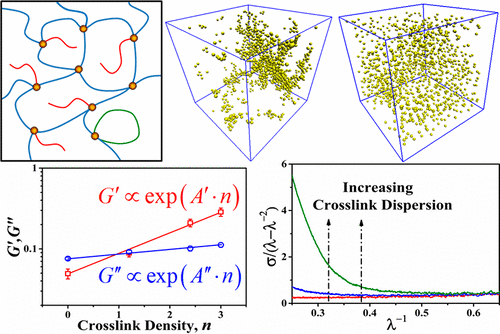当前位置:
X-MOL 学术
›
Macromolecules
›
论文详情
Our official English website, www.x-mol.net, welcomes your
feedback! (Note: you will need to create a separate account there.)
Effects of Cross-Link Density and Distribution on Static and Dynamic Properties of Chemically Cross-Linked Polymers
Macromolecules ( IF 5.1 ) Pub Date : 2018-12-18 00:00:00 , DOI: 10.1021/acs.macromol.8b01389 Jianxiang Shen 1 , Xiangsong Lin 1 , Jun Liu 2 , Xue Li 3
Macromolecules ( IF 5.1 ) Pub Date : 2018-12-18 00:00:00 , DOI: 10.1021/acs.macromol.8b01389 Jianxiang Shen 1 , Xiangsong Lin 1 , Jun Liu 2 , Xue Li 3
Affiliation

|
Molecular dynamics simulations have been performed to study the effects of the cross-link density and distribution on the network topology, the dynamic structural properties, the tensile mechanical properties, and the viscoelastic properties of chemically cross-linked polymers. Simulation results show that the introduction of cross-links slows the chain dynamics down and thus leads to a slight increase in the glass transition temperature. Improving the cross-link dispersion state is found to be essentially equivalent to increasing the effective cross-link density, as reflected in the network topological features. The structural relaxation behavior is analyzed in terms of the incoherent intermediate dynamic structure factor, and the characteristic α-relaxation time is examined by the MCT and VFT equation. The results indicate that the time–temperature superposition principle holds on the segmental length scale but fails on the chain length scale, where it can be valid at sufficiently high temperature above the critical temperature. Furthermore, the mechanical property of polymer networks is slightly influenced by the introduction of cross-links at small length scales but is significantly improved at large length scales. The polymers with high cross-link density or uniform cross-link distribution exhibit an upturn in the modulus at large deformations in Mooney–Rivlin plots due to the finite chain extensibility. By accounting for the topological defects and the cross-link constraint, the phantom model is shown to predict the network behavior well within relatively large deformations. The viscoelastic properties of polymers such as the storage modulus, the loss modulus, and the loss tangent show a positive exponential relation with the apparent cross-link density. This work may shed some light on the relevant experimental and theoretical studies on cross-linked polymers.
中文翻译:

交联密度和分布对化学交联聚合物静态和动态性能的影响
已经进行了分子动力学模拟以研究交联密度和分布对网络拓扑,化学交联聚合物的动态结构性质,拉伸机械性质和粘弹性的影响。模拟结果表明,交联的引入会降低链的动力学速度,从而导致玻璃化转变温度略有上升。如网络拓扑特征所示,发现改善交联分散状态实质上等同于增加有效交联密度。根据非相干中间动态结构因子分析了结构松弛行为,并通过MCT和VFT方程检查了特征α松弛时间。结果表明,时间-温度叠加原理在分段长度尺度上有效,但在链长度尺度上无效,在时空叠加原理在高于临界温度的足够高的温度下可以有效。此外,聚合物网络的机械性能在较小的长度范围内受到交联引入的影响较小,但在较大的长度范围内显着改善。具有高交联密度或均匀交联分布的聚合物,由于有限的链可扩展性,在门尼-里夫林图中大变形时,模量上扬。通过考虑拓扑缺陷和交联约束,幻象模型显示出可以在较大变形内很好地预测网络行为。聚合物的粘弹性,如储能模量,损耗模量和损耗正切值与表观交联密度呈正指数关系。这项工作可能会为有关交联聚合物的相关实验和理论研究提供一些启示。
更新日期:2018-12-18
中文翻译:

交联密度和分布对化学交联聚合物静态和动态性能的影响
已经进行了分子动力学模拟以研究交联密度和分布对网络拓扑,化学交联聚合物的动态结构性质,拉伸机械性质和粘弹性的影响。模拟结果表明,交联的引入会降低链的动力学速度,从而导致玻璃化转变温度略有上升。如网络拓扑特征所示,发现改善交联分散状态实质上等同于增加有效交联密度。根据非相干中间动态结构因子分析了结构松弛行为,并通过MCT和VFT方程检查了特征α松弛时间。结果表明,时间-温度叠加原理在分段长度尺度上有效,但在链长度尺度上无效,在时空叠加原理在高于临界温度的足够高的温度下可以有效。此外,聚合物网络的机械性能在较小的长度范围内受到交联引入的影响较小,但在较大的长度范围内显着改善。具有高交联密度或均匀交联分布的聚合物,由于有限的链可扩展性,在门尼-里夫林图中大变形时,模量上扬。通过考虑拓扑缺陷和交联约束,幻象模型显示出可以在较大变形内很好地预测网络行为。聚合物的粘弹性,如储能模量,损耗模量和损耗正切值与表观交联密度呈正指数关系。这项工作可能会为有关交联聚合物的相关实验和理论研究提供一些启示。











































 京公网安备 11010802027423号
京公网安备 11010802027423号